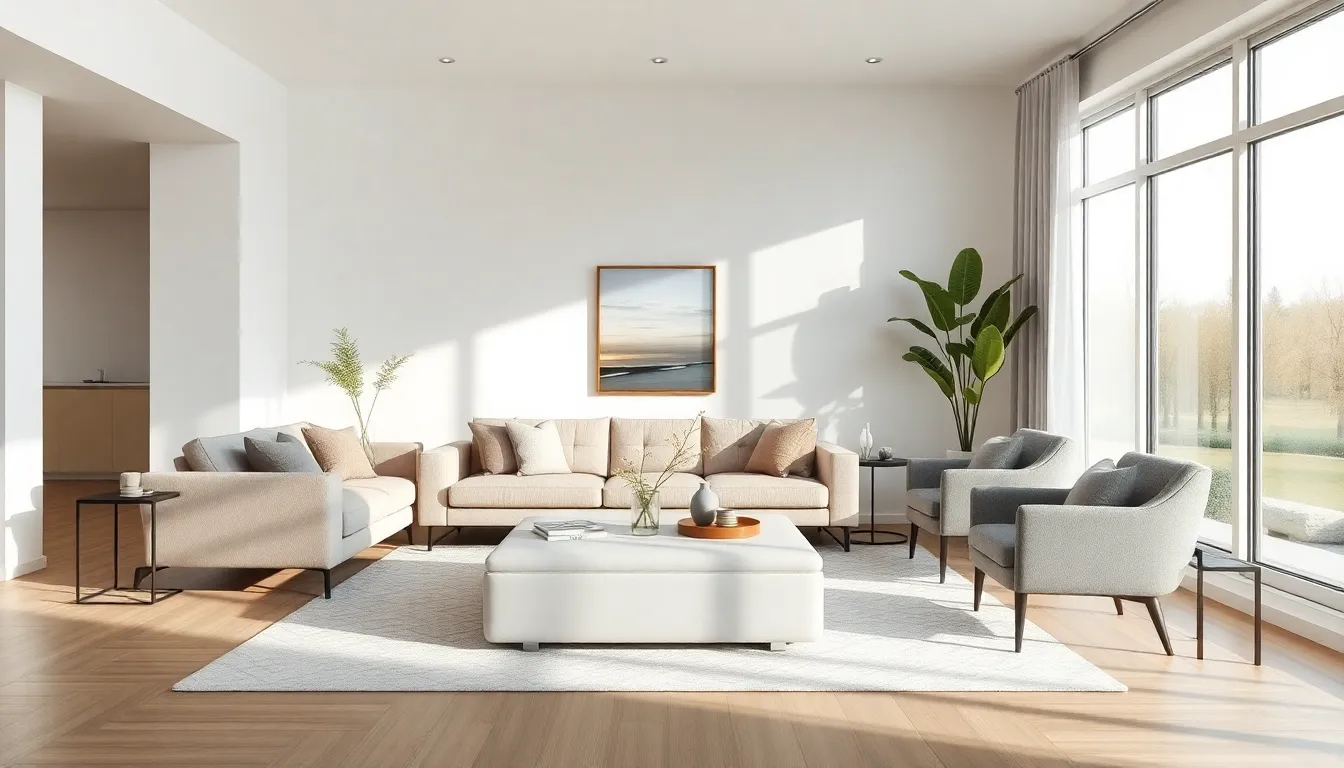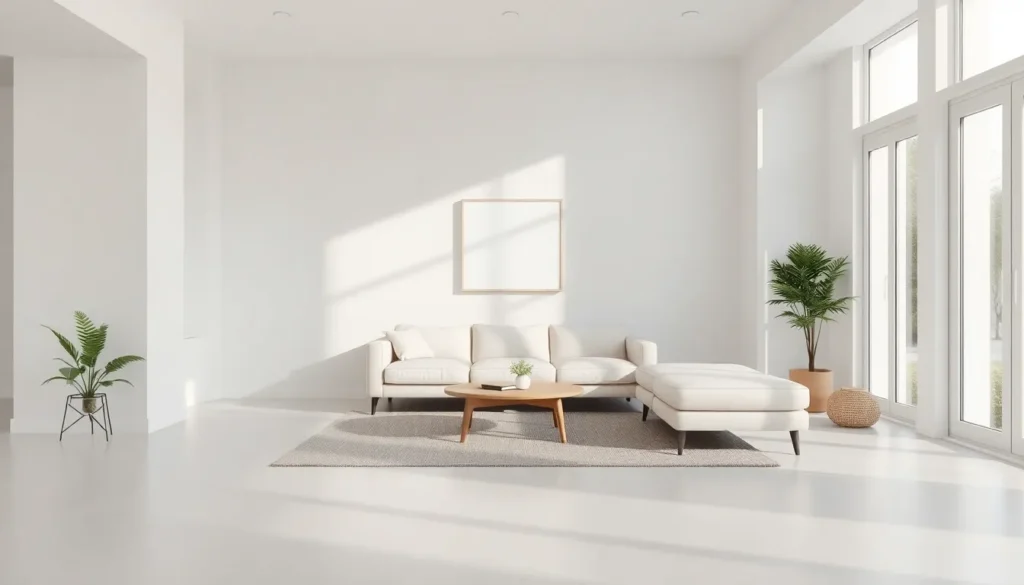In a world bursting with clutter and chaos, a minimalist living room offers a refreshing escape. Imagine stepping into a space where less truly is more. It’s not just about fewer items; it’s about creating an atmosphere that breathes tranquility and style. Who wouldn’t want to kick back in a room that feels like a serene oasis, free from distractions and full of personality?
Table of Contents
ToggleOverview of Minimalist Decor
Minimalist decor focuses on simplicity and functionality in design. Space showcases essential elements, maximizing openness and light. A neutral color palette often dominates, featuring whites, grays, and earth tones. Furnishings typically consist of streamlined, geometric shapes, reducing visual clutter.
Designers emphasize the quality of materials, opting for natural fibers and sustainable elements. Artwork remains intentional and curated, allowing for meaningful expression without overwhelming the senses. Lighting fixtures enhance ambiance, offering both practicality and aesthetic appeal.
Storage solutions include hidden compartments and multifunctional furniture, helping maintain an organized environment. Accessories reflect personal style yet remain discreet, avoiding excessive ornamentation. Minimalism promotes a sense of calm, enabling individuals to connect with their surroundings genuinely.
By prioritizing experiences over possessions, minimalist decor encourages mindfulness. This design philosophy fosters focus and relaxation, contributing to overall well-being. Spaces designed with these principles create inviting atmospheres that blend minimalism with individual expression.
Key Elements of Minimalist Decor Living Room

Minimalist decor emphasizes simplicity and harmony, creating a serene ambiance in the living room. Key elements contribute to achieving this aesthetic and functional design.
Color Palette
A neutral color palette plays a crucial role in minimalist decor. Shades like white, beige, and soft gray enhance the sense of space while reflecting light effectively. Accent colors can inspire vibrancy without overwhelming the room’s tranquility. Utilizing monochromatic tones adds depth yet retains a calm atmosphere. Bright and bold hues might distract from the overall feel, so focusing on soft alternatives fosters relaxation.
Furniture Selection
Furniture selection significantly impacts the minimalist living room’s design. Pieces often exhibit clean lines and streamlined shapes, promoting an uncluttered look. Choose multifunctional furniture, like ottomans that serve as storage units or coffee tables with hidden compartments. Quality over quantity highlights essential items rather than an excess of decor. Low-profile sofas paired with simple chairs offer comfort while ensuring a spacious feel. Aim for visual harmony through balanced proportions and strategically positioned items, allowing easy circulation throughout the space.
Designing a Functional Space
Creating a functional space in a minimalist living room revolves around simplicity, openness, and purposeful design. Focus must remain on layout, storage, and organization to foster tranquility.
Layout Considerations
Arranging furniture in a minimalist living room requires attention to flow and function. Position seating arrangements to encourage conversation while ensuring walkways remain clear. Consider using area rugs to define spaces without creating visual clutter. Place larger furniture pieces against walls to maximize open floor space. Opt for fewer items with multifunctional uses to enhance usability without overwhelming the room. Every arrangement needs to promote comfort and accessibility while emphasizing the room’s serene aesthetic.
Storage Solutions
Effective storage serves as a foundation for minimalist decor. Incorporate furniture with built-in storage, such as ottomans or coffee tables, to conceal items without sacrificing style. Floating shelves offer a way to display essential personal items while keeping surfaces clutter-free. Utilize baskets and decorative boxes to organize smaller objects discreetly. Select furniture that serves dual purposes, such as a sofa bed or a bench with storage inside. Maintaining an organized space significantly enhances the minimalist ethos, promoting mindfulness and reducing distractions.
Tips for Achieving Minimalist Decor
Choose a neutral color palette to create a serene atmosphere. Soft shades and monochromatic tones foster relaxation without overwhelming the senses. Incorporate streamlined furnishings that align with the minimalist aesthetic, emphasizing clean lines and multifunctional designs.
Opt for low-profile furniture to maintain an uncluttered appearance. Quality matters, so prioritize essential items that enhance the overall feel of the space. Arrange furniture thoughtfully to encourage conversation while ensuring clear walkways to promote ease of movement.
Utilize area rugs to define areas without introducing visual clutter. Select decorative elements intentionally, ensuring they enhance the space without causing distractions. Storage remains crucial—consider options like furniture with built-in storage or floating shelves to display personal items while keeping surfaces clear.
Maintain organization through regular decluttering, reinforcing the minimalist ethos. By reducing excess, individuals enhance tranquility and mindfulness within the living room. Establish a sense of visual harmony through careful placement of accessories and art.
Incorporate practical lighting solutions to elevate the ambiance. Lighting can create a warm, inviting environment that resonates with the minimalist approach. Avoid excessive ornamentation; instead, focus on pieces that reflect personal style while adhering to simplicity.
Practice mindful consumption when adding new items. Each piece should serve a purpose and contribute meaningfully to the living room’s overall design. Adopting these strategies will lead to a tranquil space that exemplifies minimalist decor.
Examples of Minimalist Decor Living Rooms
Several examples illustrate the beauty of minimalist decor in living rooms.
A neutral color palette often defines successful minimalist spaces, with shades of white, beige, or soft gray predominating. These colors enhance openness, reflecting light and creating a calming atmosphere.
Furniture selection plays a crucial role in maintaining a minimalist aesthetic. Streamlined sofas and chairs with clean lines provide comfort without clutter. Low-profile furniture pieces contribute to an airy feel, ensuring that no single item overwhelms the space.
Artwork should remain intentional and minimal. A single large canvas or a collection of smaller pieces, arranged thoughtfully, adds personal expression without introducing visual chaos.
Effective storage solutions elevate minimalist designs. Built-in shelves or hidden compartments keep surfaces clear, promoting organization and tranquility. Each item serves a purpose, ensuring that decorations do not distract from the serene environment.
Lighting enhances the minimalist aesthetic by offering practicality and warmth. Pendant lights or floor lamps with simple designs illuminate spaces effectively while avoiding excessive ornamentation.
Area rugs in soft, solid colors define specific areas within the living room, such as seating or reading nooks, while maintaining visual clarity.
Textured materials, like a soft throw blanket or natural fiber cushions, add interest without overwhelming the space. Focusing on quality pieces ensures a cohesive, elegant look.
These examples demonstrate how minimalist decor can create inviting, tranquil living spaces. Through careful selection and mindful arrangement, it’s possible to cultivate environments that prioritize peace and simplicity.
Embracing minimalist decor in the living room transforms it into a serene retreat. By prioritizing simplicity and functionality, individuals can create a space that fosters relaxation and personal expression.
The careful selection of colors, furniture, and lighting plays a crucial role in achieving this aesthetic. Thoughtful arrangements and effective storage solutions maintain an uncluttered environment while reflecting personal style.
Ultimately, minimalist decor encourages mindfulness and promotes well-being, allowing individuals to enjoy their living spaces without the distractions of excess. A minimalist approach not only enhances the beauty of a room but also enriches the overall living experience.

